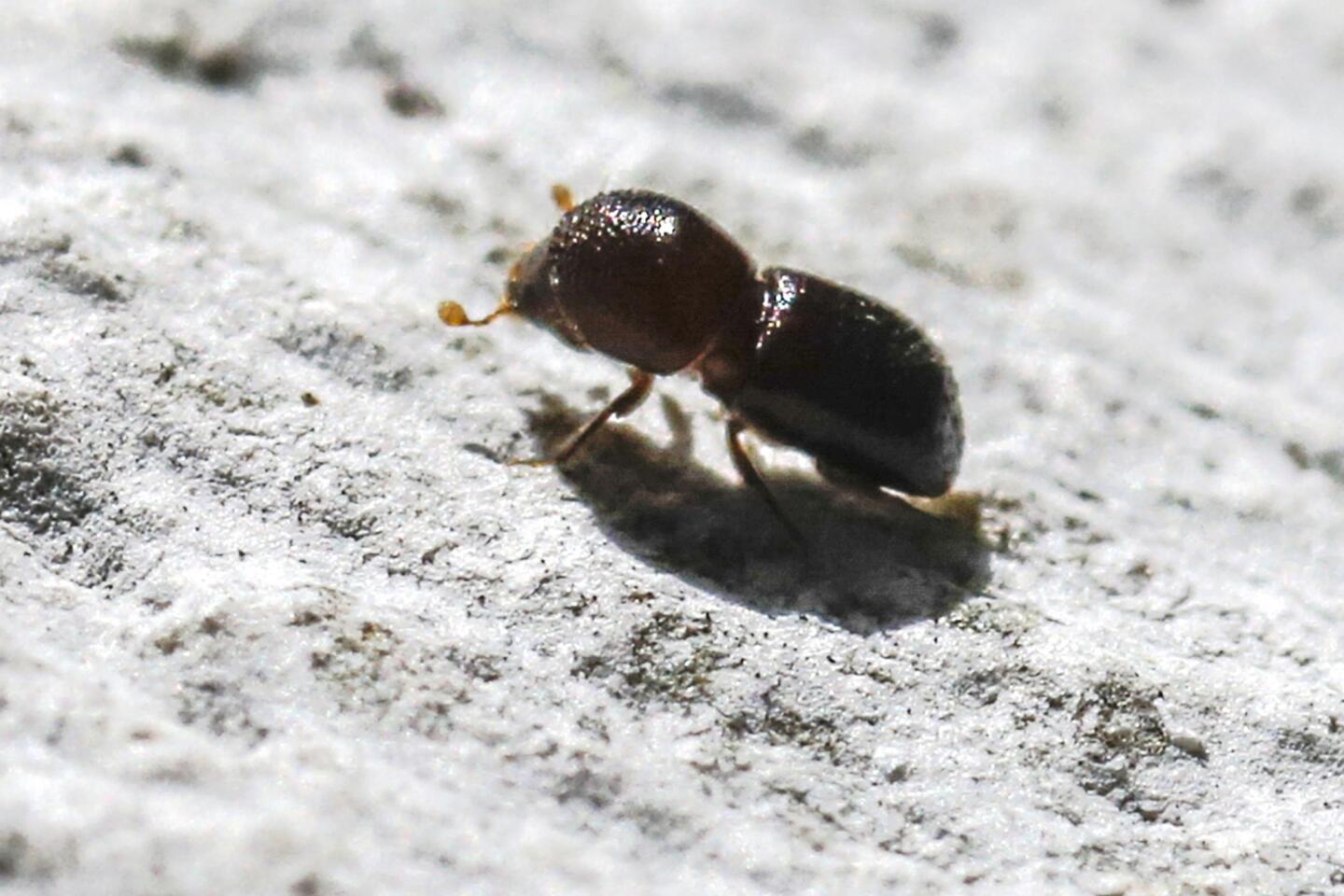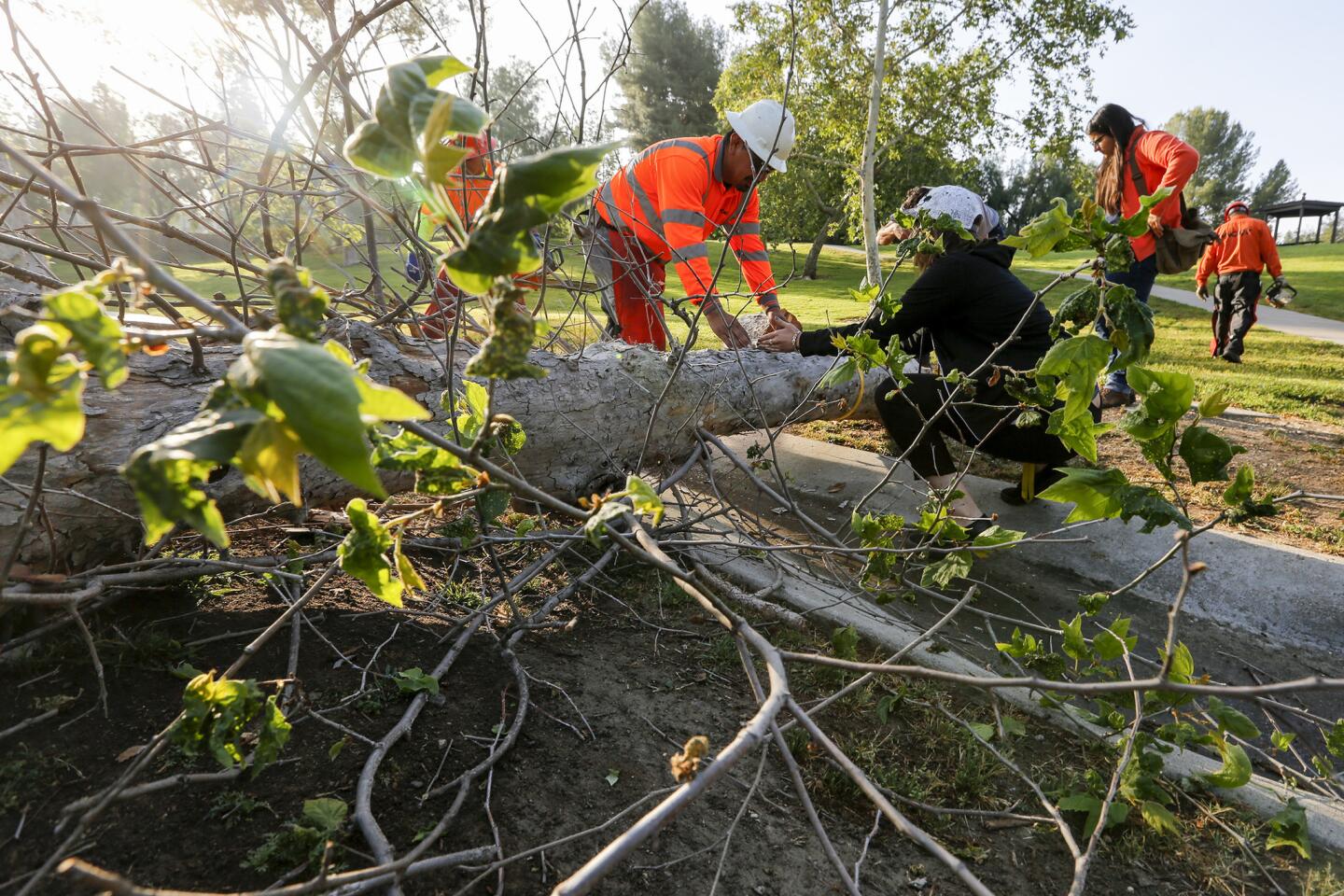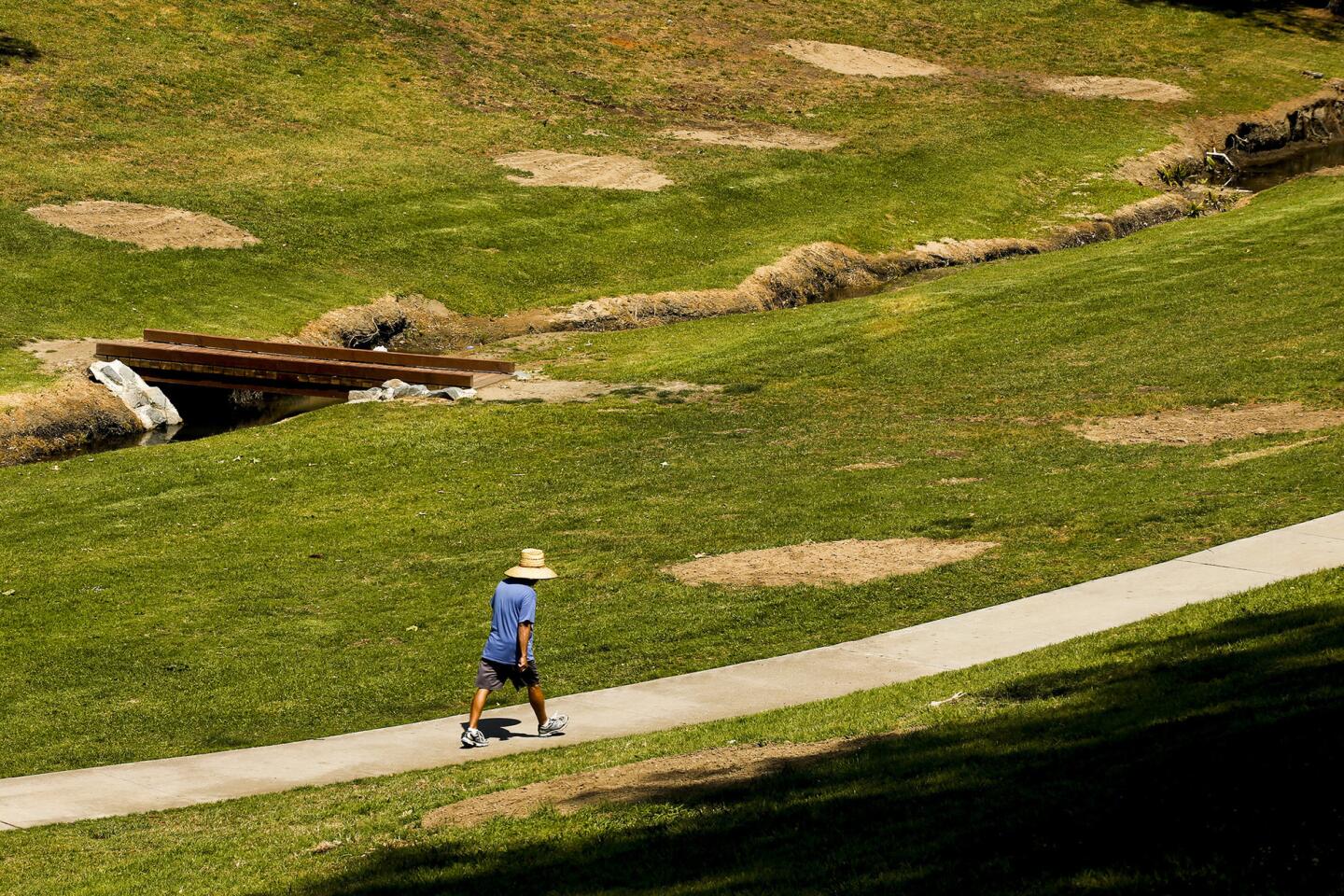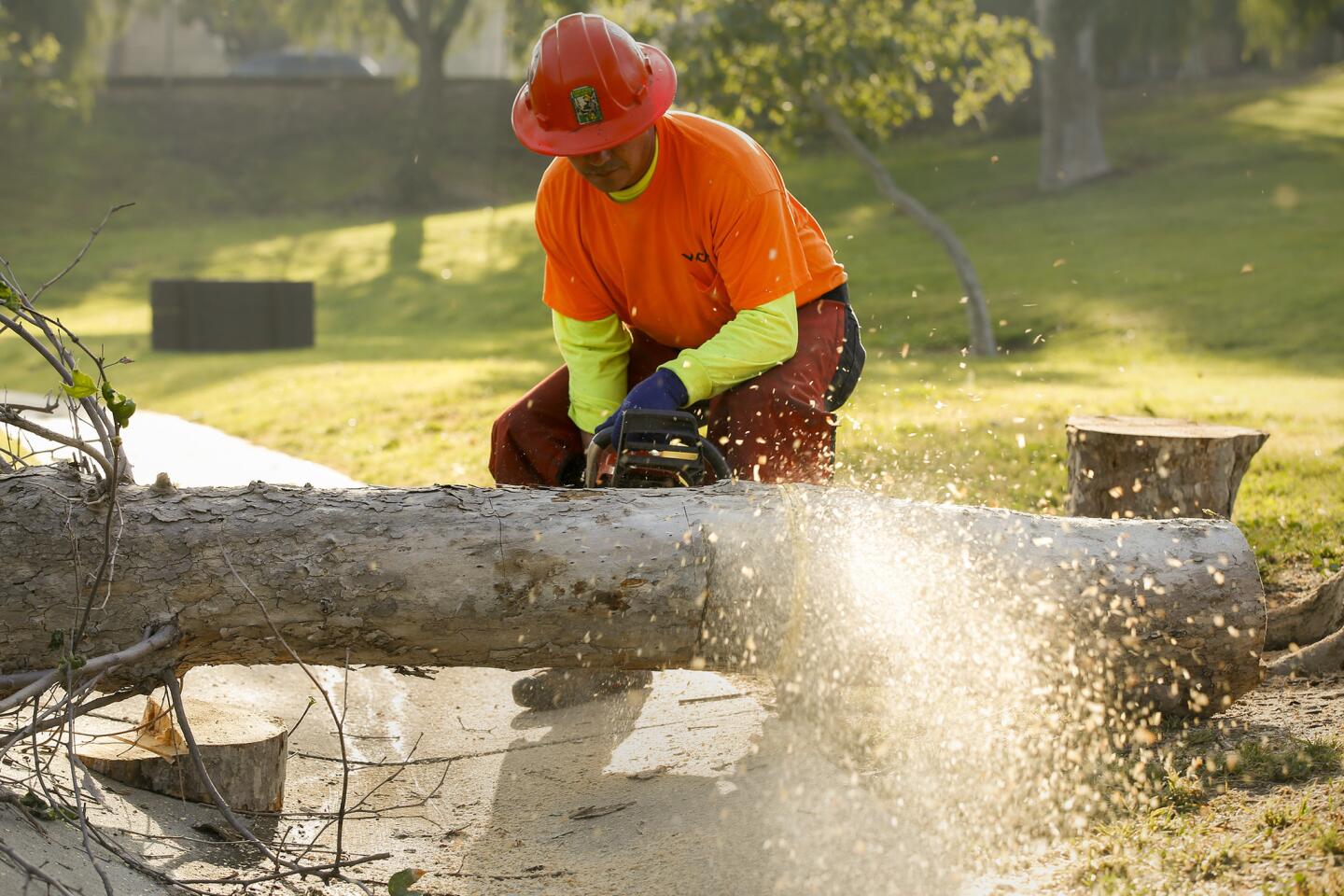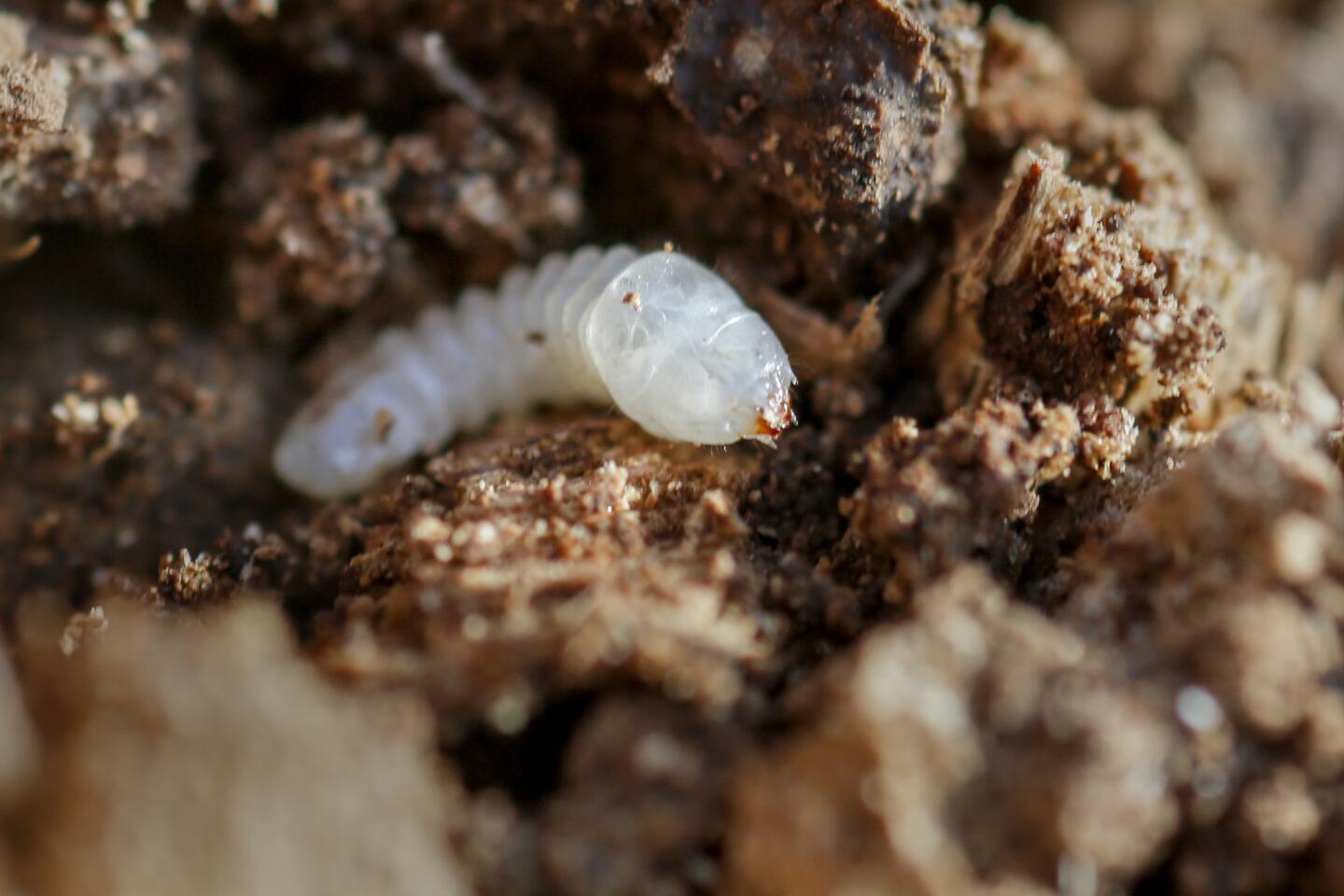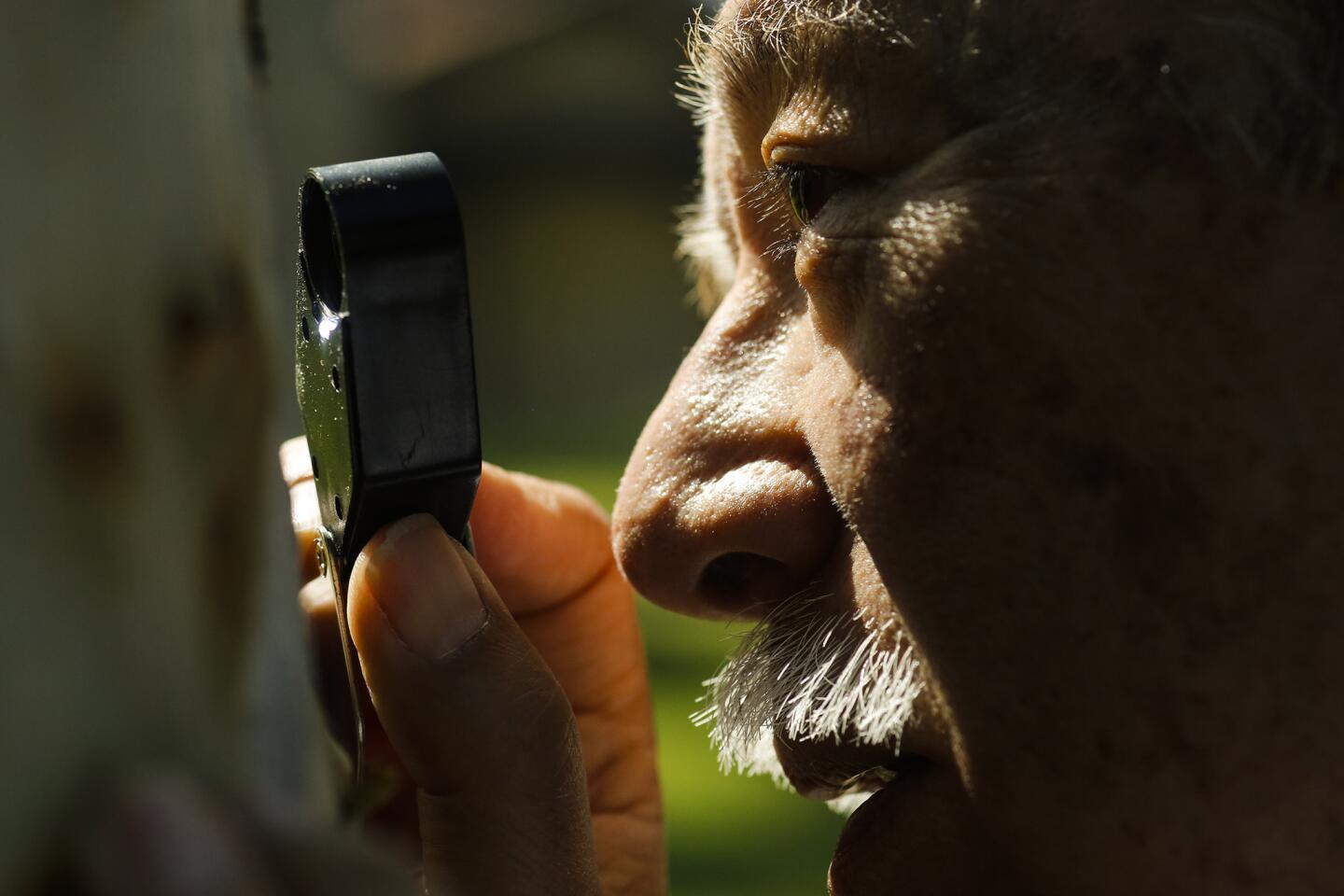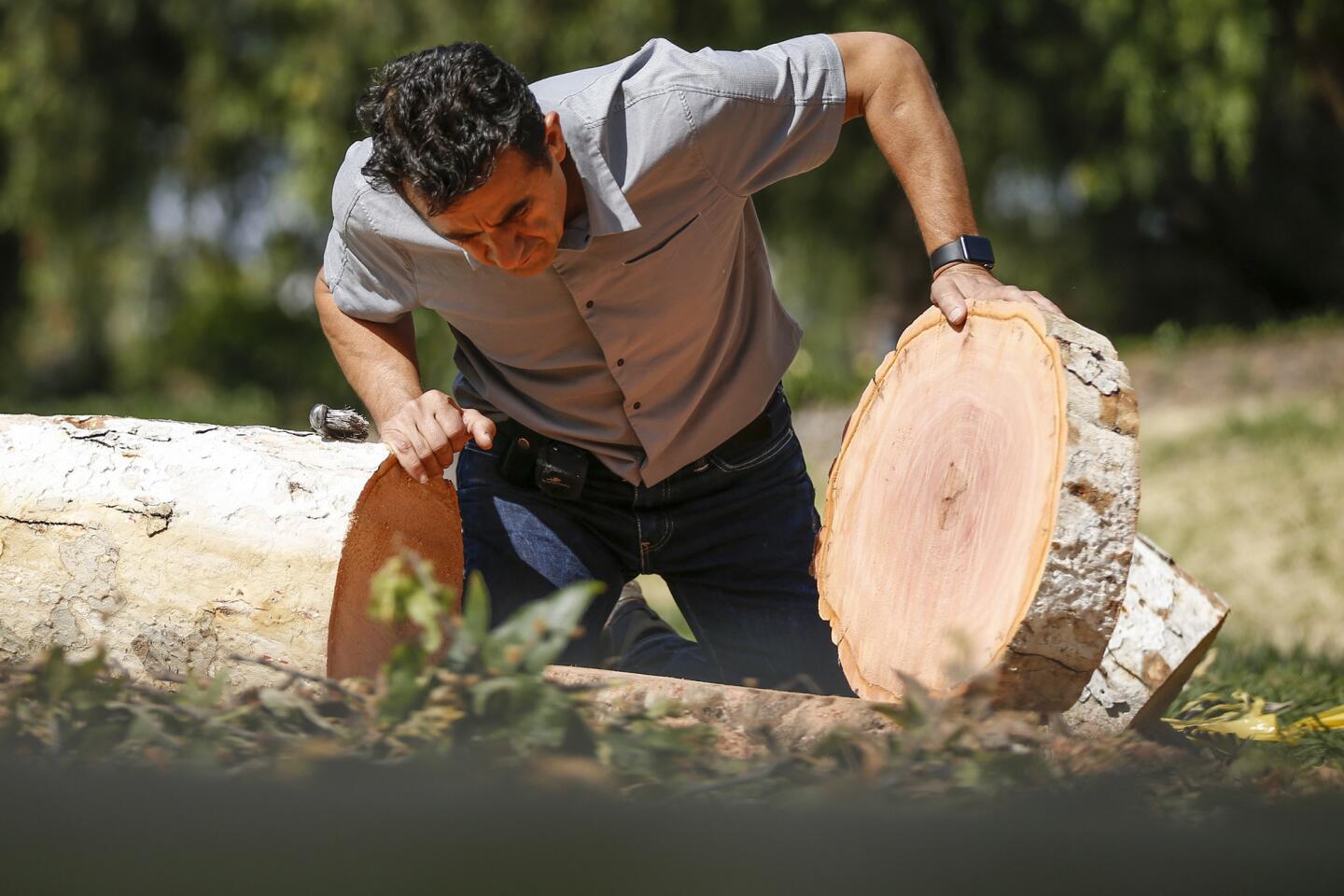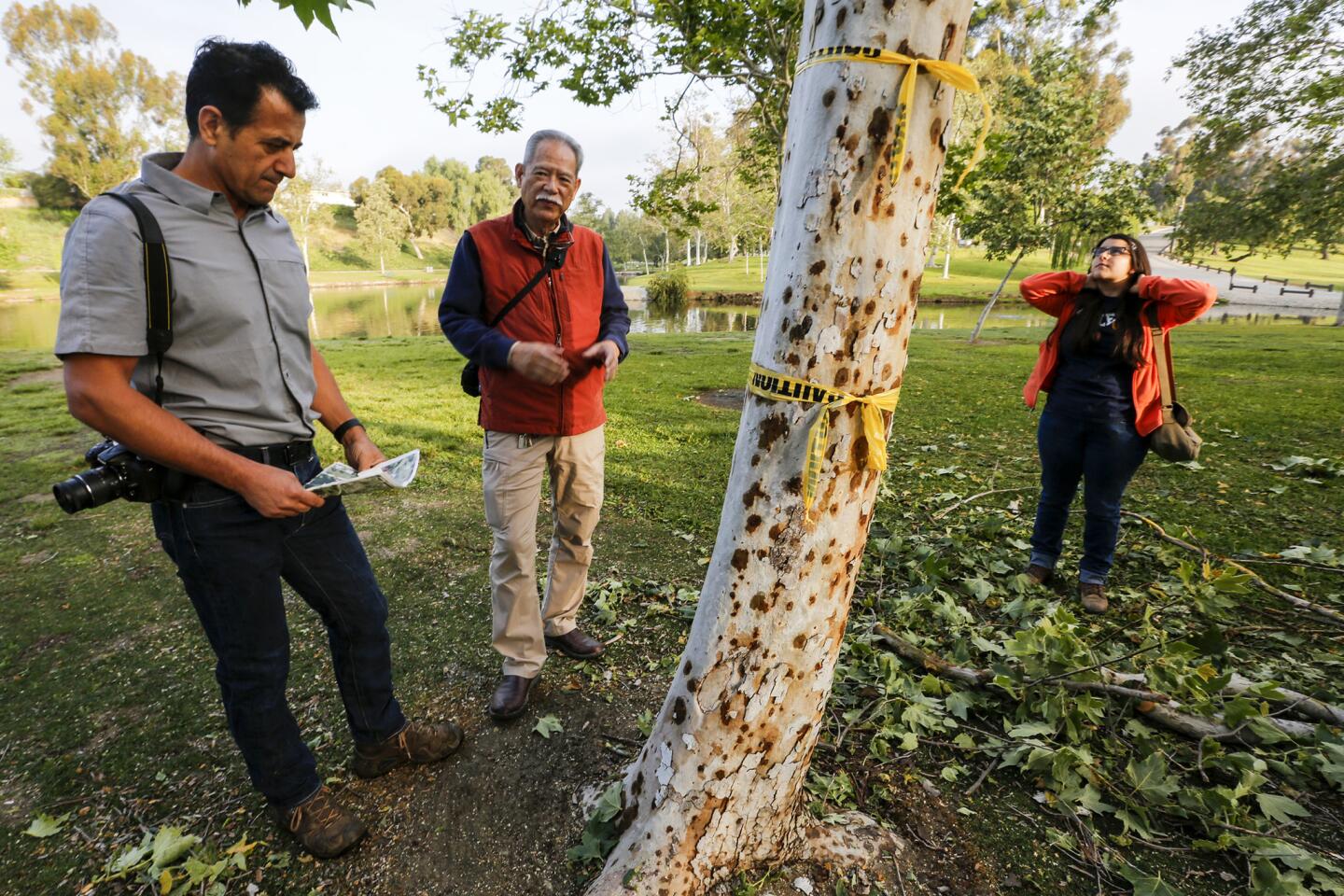The trees that make Southern California shady and green are dying. Fast

One type of beetle could kill as many as 27 million trees in Los Angeles, Orange, Riverside and San Bernardino counties, including parts of the desert. Video by Mark Boster / Los Angeles Times
- Share via
The trees that shade, cool and feed people from Ventura County to the Mexican border are dying so fast that within a few years it’s possible the region will look, feel, sound and smell much less pleasant than it does now.
“We’re witnessing a transition to a post-oasis landscape in Southern California,” says Greg McPherson, a supervisory research forester with the U.S. Forest Service who has been studying what he and others call an unprecedented die-off of the trees greening Southern California’s parks, campuses and yards.
Botanists in recent years have documented insect and disease infestations as they’ve hop-scotched about the region, devastating Griffith Park’s sycamores and destroying over 100,000 willows in San Diego County’s Tijuana River Valley Regional Park, for example.
It’s heartbreaking to see trees dying in such dramatic numbers in famously lush cities like Pasadena, Alhambra and Arcadia.
— Jerrold Turney, plant pathologist for Los Angeles County.
McPherson’s is the first survey to quantify and assess the big picture.
It’s not a pretty one.
His initial estimate is that just one particularly dangerous menace — the polyphagous shot hole borer beetle — could kill as many as 27 million trees in Los Angeles, Orange, Riverside and San Bernardino counties, including parts of the desert.
That’s roughly 38% of the 71 million trees in the 4,244 square mile urban region with a population of about 20 million people.
And that insect is just one of the imminent threats.
“Many of the trees we grow evolved in temperate climates and can’t tolerate the stress of drought, water restrictions, higher salinity levels in recycled water, wind and new pests that arrive almost daily via global trade and tourism, local transportation systems, nurseries and the movement of infected firewood,” he said.
There will be no miraculous recovery of these urban ecosystems after the beetles are done with them.
— Mark Hoddle, director of UC Riverside’s Center for Invasive Species.

If as many trees as projected die, the cost to remove and replace them could be about $36 billion, he said.
But Southern Californians would face many other costs.
“Catastrophic loss of our canopy,” McPherson said, “would have consequences for human health and well-being, property values, air-conditioning savings, carbon storage, the removal of pollutants from the air we breathe, and wildlife habitat.”
Jerrold Turney, plant pathologist for Los Angeles County, likened the surge in urban tree mortality to “watching a train wreck in slow motion.”
“It’s heartbreaking,” he said, “to see trees dying in such dramatic numbers in famously lush cities like Pasadena, Alhambra and Arcadia: sycamores, all the maples, olives, liquidambers, flower plums, myrtles, oleanders and oaks.”
Mark Hoddle, director of UC Riverside’s Center for Invasive Species, said that the tree loss is “starting to cascade across the urban landscape.”
“Without shade trees, water temperatures will rise and algae will bloom in riparian areas, for instance,” Hoddle said. “As a result, fish, frog and native insect populations will diminish, along with the pleasure of hiking, because there’ll be nothing to look at but dead boughs of trees.”
“And,” he added, “there will be no miraculous recovery of these urban ecosystems after the beetles are done with them.”
Among the hardest-hit native species of urban trees are California sycamores, typically found along streams and commonly used as shade and street trees in places such as Griffith Park and along downtown’s Wilshire Boulevard.
“Here’s the sad news about sycamores,” said Akif Eskalen, a plant pathologist at the University of California, Riverside. “If we cannot control the shot hole borer, it will kill all the sycamores in California. And when they’re done with sycamores, they’ll move to other trees.”
By 2012, pathologists knew that the shot hole borer was transmitting a fatal fungal disease to 19 species of trees in Southern California, he said. Since then, scientists have identified 30 additional host species.
If we cannot control the shot hole borer, it will kill all the sycamores in California.
— Akif Eskalen, plant pathologist at the University of California, Riverside.
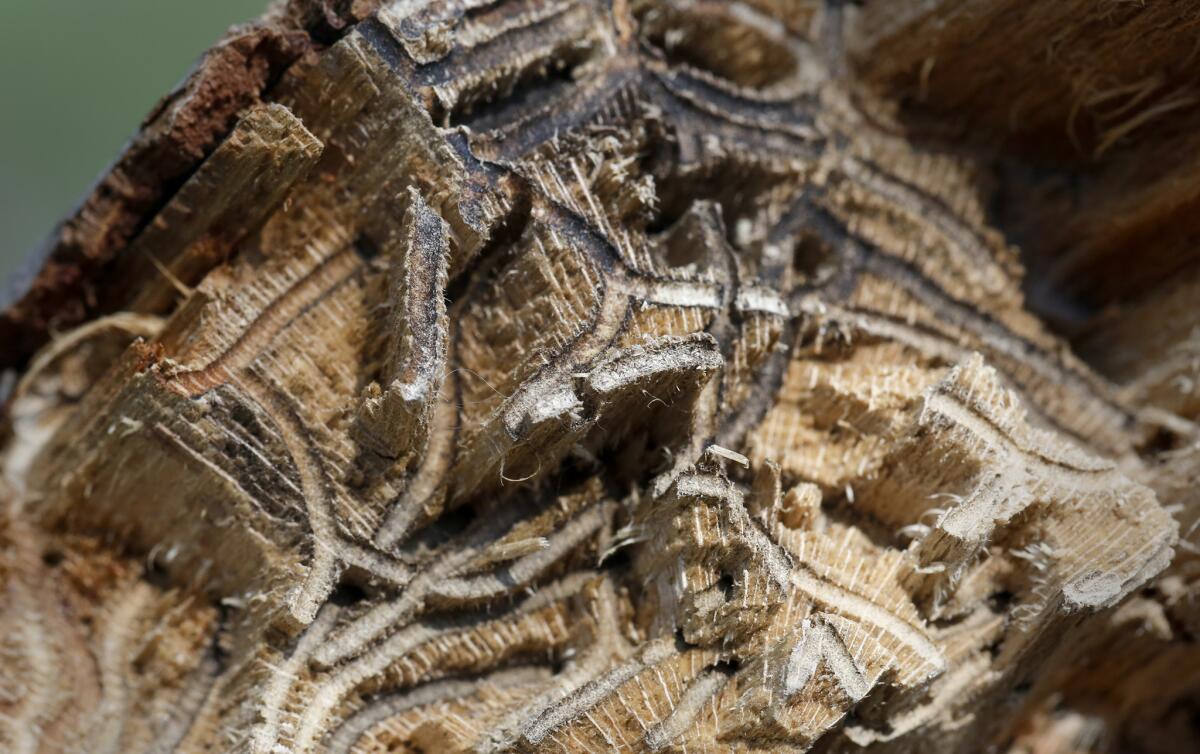
“We expect the number of tree hosts to grow even higher over the next few years,” Eskalen said. “And at this point, there’s not much we can do about that.”
Meanwhile, the relatively recent invasion of shot hole borers is only part of the crisis that scientists are scrambling to control.
- In San Diego County, it was a cousin of the ployphagous beetle, the Kuroshio shot hole borer, that infested more than 144,000 willow trees in Tijuana River Valley Regional Park last year, officials said.
- The goldspotted oak borer has killed tens of thousands of drought-stressed oak trees while moving from San Diego County to Los Angeles County.
- The aphid-size Asian citrus psyllid is transferring an incurable bacterial disease from tree to tree as it feeds on citrus leaves.
- A flying insect known as the glassy-winged sharpshooter is spreading oleander leaf scorch, a bacterial disease that was first discovered in the Palm Springs area and has now spread throughout Southern California.
- The 1 1/2-inch-long South American palm weevil poses a serious threat to palms throughout the Southwestern United States after turning up in 2016 in the neighborhoods just north of the Mexican border.
In Orange County’s Holy Jim Canyon, “the word is plague,” said Michael Milligan, chief of the local volunteer fire department. “Thousands of dead and still-standing alders look like pick-up sticks propped up along the creek.”
At Craig Regional Park in Fullerton, circular dirt patches of dirt are all that remains of dozens of venerable sycamores that had shaded a canyon where families came to picnic and even hold weddings.
Vanessa Fields, 47, of Brea, and her friend Diane Swanson, 67, of Buena Park, were stunned by the devastation they came upon during a lunch-hour stroll on a recent weekday.
“What the heck happened here?” Fields asked. “Where’s the gorgeous trees?”
That same day, horticulture expert John Kabashima was checking up on one of the many stricken sycamores at that park.
Peering through a magnifying glass, he marveled at the persistence of polyphagous beetles fulfilling their complex life-cycles. The bugs are smaller than sesame seeds, but they bore by the thousands into the bark, then line the tunnels with a species of fungi that disrupts the transport of water and nutrients from roots to leaves. Within a few weeks, their larvae hatch, mature and mate to produce new generations in the tree.
“This pest is unusual in that it reproduces . . . within the tree,” he said. “As a result, it is extremely difficult to reach and treat.”
When it comes to invasive insects and disease, agriculture gets all the attention and money.
— John Kabashima, horticulturist
Kabashima said state and federal officials have been slow to respond with organized campaigns to eradicate the pests that are ravaging the trees because urban forests don’t support logging crews and regional economies.
“When it comes to invasive insects and disease, agriculture gets all the attention and money,” Kabashima said with a sigh. “Urban forests have been left out in the cold.”
::
Many of the invasive insects and diseases ravaging Southern California arrived as stowaways on trees and plants installed during the post-World War II housing boom.
Unchecked by natural predators, their numbers exploded during the most severe drought on record, which officially ended earlier this month.
Scientists say that an average of nine new insect species establish populations on the landscape each year, and three of those interlopers become significant pests.
Frank McDonough, botanist at the Los Angeles County Arboretum, suggested that urban forests are suffering partly because “so many of the trees we grow don’t belong here and aren’t sustainable without plentiful supplies of imported water.”
“Historic photos of the region show coastal shrubs, oaks on the foothills and sycamores along streams and rivers,” he said. “Yet, we planted way too many trees from areas that get two to three times as much rain as we do.”
Liquidambar is one example. The species evolved in the Southeastern United States, then developers and property owners planted it in Southern California after World War II. At the time, the trees seemed perfect: Not too tall, with lustrous maple-like leaves that turn into a spectacular show of yellow, pink and red hues in the fall.
Decades later, leaf scorch, shot hole borers and drought are quickly adding Liquidambar to the long list of trees whose days in Southern California appear to be numbered.
Andy Lipkis, founder of the nonprofit TreePeople, said Southern Californians are starting to pay attention to the crisis, recognizing just how indebted they are to the region’s trees.
“Losing our trees would cost us a lot,” he said, including “the accelerated loss of the California Dream in neighborhoods throughout the region.”
“Trees” he said, “reduce heat and light intensity, protect water, rid the air of pollutants and instill a sense of peace by filling the landscape with the sights, smells and sounds of nature.”
McPherson said he hopes his report wakes up the state’s leaders to the die-off. The next steps, he said, should include monitoring the unprecedented damage the urban forests are suffering, and taking steps to remove dead trees and plant new, probably different ones: “a new, diverse palette of well-adapted species that may not be currently available in nurseries.”
“It may be, for example, that trees that grow well in, say, Phoenix ... are the ones that will grow well in Los Angeles in decades to come,” he said.
ALSO
Los Angeles State Historic Park is about to open after 16 years of delays
Polar bear at SeaWorld San Diego dies after a brief, unexplained illness
L.A. County creates a lower-cost alternative for Southern California Edison customers
More to Read
Sign up for Essential California
The most important California stories and recommendations in your inbox every morning.
You may occasionally receive promotional content from the Los Angeles Times.
